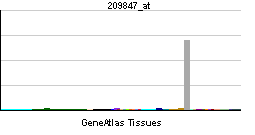CDH17
| Cadherin 17, LI cadherin (liver-intestine) | |||||||||||
|---|---|---|---|---|---|---|---|---|---|---|---|
| Identifiers | |||||||||||
| Symbols | CDH17 ; CDH16; FLJ26931; HPT-1; HPT1; MGC138218; MGC142024 | ||||||||||
| External IDs | Template:OMIM5 Template:MGI HomoloGene: 56859 | ||||||||||
| |||||||||||
| RNA expression pattern | |||||||||||
 | |||||||||||
| More reference expression data | |||||||||||
| Orthologs | |||||||||||
| Template:GNF Ortholog box | |||||||||||
| Species | Human | Mouse | |||||||||
| Entrez | n/a | n/a | |||||||||
| Ensembl | n/a | n/a | |||||||||
| UniProt | n/a | n/a | |||||||||
| RefSeq (mRNA) | n/a | n/a | |||||||||
| RefSeq (protein) | n/a | n/a | |||||||||
| Location (UCSC) | n/a | n/a | |||||||||
| PubMed search | n/a | n/a | |||||||||
Cadherin 17, LI cadherin (liver-intestine), also known as CDH17, is a human gene.[1]
This gene is a member of the cadherin superfamily, genes encoding calcium-dependent, membrane-associated glycoproteins. The encoded protein is cadherin-like, consisting of an extracellular region, containing 7 cadherin domains, and a transmembrane region but lacking the conserved cytoplasmic domain. The protein is a component of the gastrointestinal tract and pancreatic ducts, acting as an intestinal proton-dependent peptide transporter in the first step in oral absorption of many medically important peptide-based drugs. The protein may also play a role in the morphological organization of liver and intestine.[1]
References
Further reading
- Gessner R, Tauber R (2001). "Intestinal cell adhesion molecules. Liver-intestine cadherin". Ann. N. Y. Acad. Sci. 915: 136–43. PMID 11193569.
- Gilston A (1978). "Reducing the hazard of disconnected tubes". Anaesthesia. 32 (9): 922. PMID 603017.
- Dantzig AH, Hoskins JA, Tabas LB; et al. (1994). "Association of intestinal peptide transport with a protein related to the cadherin superfamily". Science. 264 (5157): 430–3. PMID 8153632.
- Kremmidiotis G, Baker E, Crawford J; et al. (1998). "Localization of human cadherin genes to chromosome regions exhibiting cancer-related loss of heterozygosity". Genomics. 49 (3): 467–71. doi:10.1006/geno.1998.5281. PMID 9615235.
- Chalmers IJ, Höfler H, Atkinson MJ (1999). "Mapping of a cadherin gene cluster to a region of chromosome 5 subject to frequent allelic loss in carcinoma". Genomics. 57 (1): 160–3. doi:10.1006/geno.1998.5717. PMID 10191097.
- Suzuki Y, Tsunoda T, Sese J; et al. (2001). "Identification and characterization of the potential promoter regions of 1031 kinds of human genes". Genome Res. 11 (5): 677–84. doi:10.1101/gr.164001. PMID 11337467.
- Grötzinger C, Kneifel J, Patschan D; et al. (2001). "LI-cadherin: a marker of gastric metaplasia and neoplasia". Gut. 49 (1): 73–81. PMID 11413113.
- Strausberg RL, Feingold EA, Grouse LH; et al. (2003). "Generation and initial analysis of more than 15,000 full-length human and mouse cDNA sequences". Proc. Natl. Acad. Sci. U.S.A. 99 (26): 16899–903. doi:10.1073/pnas.242603899. PMID 12477932.
- Takamura M, Sakamoto M, Ino Y; et al. (2003). "Expression of liver-intestine cadherin and its possible interaction with galectin-3 in ductal adenocarcinoma of the pancreas". Cancer Sci. 94 (5): 425–30. PMID 12824888.
- Wendeler MW, Praus M, Jung R; et al. (2004). "Ksp-cadherin is a functional cell-cell adhesion molecule related to LI-cadherin". Exp. Cell Res. 294 (2): 345–55. doi:10.1016/j.yexcr.2003.11.022. PMID 15023525.
- Ko S, Chu KM, Luk JM; et al. (2004). "Overexpression of LI-cadherin in gastric cancer is associated with lymph node metastasis". Biochem. Biophys. Res. Commun. 319 (2): 562–8. doi:10.1016/j.bbrc.2004.04.197. PMID 15178443.
- Takamura M, Ichida T, Matsuda Y; et al. (2004). "Reduced expression of liver-intestine cadherin is associated with progression and lymph node metastasis of human colorectal carcinoma". Cancer Lett. 212 (2): 253–9. doi:10.1016/j.canlet.2004.03.016. PMID 15279905.
- Beausoleil SA, Jedrychowski M, Schwartz D; et al. (2004). "Large-scale characterization of HeLa cell nuclear phosphoproteins". Proc. Natl. Acad. Sci. U.S.A. 101 (33): 12130–5. doi:10.1073/pnas.0404720101. PMID 15302935.
- Wang XQ, Luk JM, Leung PP; et al. (2005). "Alternative mRNA splicing of liver intestine-cadherin in hepatocellular carcinoma". Clin. Cancer Res. 11 (2 Pt 1): 483–9. PMID 15701831.
- Wang XQ, Luk JM, Garcia-Barcelo M; et al. (2007). "Liver intestine-cadherin (CDH17) haplotype is associated with increased risk of hepatocellular carcinoma". Clin. Cancer Res. 12 (17): 5248–52. doi:10.1158/1078-0432.CCR-06-0558. PMID 16951245.
| This protein-related article is a stub. You can help Wikipedia by expanding it. |